I have the following df, weekly spend in a number of shops:
shop1 shop2 shop3 shop4 shop5 shop6 shop7 \
date_week
2 4328.85 5058.17 3028.68 2513.28 4204.10 1898.26 2209.75
3 5472.00 5085.59 3874.51 1951.60 2984.71 1416.40 1199.42
4 4665.53 4264.05 2781.70 2958.25 4593.46 2365.88 2079.73
5 5769.36 3460.79 3072.47 1866.19 3803.12 2166.84 1716.71
6 6267.00 4033.58 4053.70 2215.04 3991.31 2382.02 1974.92
7 5436.83 4402.83 3225.98 1761.87 4202.22 2430.71 3091.33
8 4850.43 4900.68 3176.00 3280.95 3483.53 4115.09 2594.01
9 6782.88 3800.03 3865.65 2221.43 4116.28 2638.28 2321.55
10 6248.18 4096.60 5186.52 3224.96 3614.24 2541.00 2708.36
11 4505.18 2889.33 2937.74 2418.34 5565.57 1570.55 1371.54
12 3115.26 1216.82 1759.49 2559.81 1403.61 1550.77 478.34
13 4561.82 827.16 4661.51 3197.90 1515.63 1688.57 247.25
shop8 shop9
date_week
2 3578.81 3134.39
3 4625.10 2676.20
4 3417.16 3870.00
5 3980.78 3439.60
6 3899.42 4192.41
7 4190.60 3989.00
8 4786.40 3484.51
9 6433.02 3474.66
10 4414.19 3809.20
11 3590.10 3414.50
12 4297.57 2094.00
13 3963.27 871.25
If I plot these in a line plot or "spaghetti plot" It works fine.
The goal is the look at trend in weekly sales over the last three months in 9 stores.
But looks a bit messy:
newgraph.plot()
I had a look at similar questions such as this one which uses df.interpolate() but it looks like I need to have missing values in there first. this answer seems to require a time series.
Is there another method to smoothen out the lines?
It doesn't matter if the values are not exactly accurate anymore, some interpolation is fine. All I am interested in is the trend over the last number of weeks. I have also tried logy=True in the plot() method to calm the lines a bit, but it didn't help.
My df, for pd.DataFrame.fromt_dict():
{'shop1': {2: 4328.849999999999,
3: 5472.0,
4: 4665.530000000001,
5: 5769.36,
6: 6267.0,
7: 5436.83,
8: 4850.43,
9: 6782.879999999999,
10: 6248.18,
11: 4505.18,
12: 3115.26,
13: 4561.82},
'shop2': {2: 5058.169999999993,
3: 5085.589999999996,
4: 4264.049999999997,
5: 3460.7899999999977,
6: 4033.579999999998,
7: 4402.829999999999,
8: 4900.679999999997,
9: 3800.0299999999997,
10: 4096.5999999999985,
11: 2889.3300000000004,
12: 1216.8200000000002,
13: 827.16},
'shop3': {2: 3028.679999999997,
3: 3874.5099999999984,
4: 2781.6999999999994,
5: 3072.4699999999984,
6: 4053.6999999999966,
7: 3225.9799999999987,
8: 3175.9999999999973,
9: 3865.6499999999974,
10: 5186.519999999996,
11: 2937.74,
12: 1759.49,
13: 4661.509999999998},
'shop4': {2: 2513.2799999999997,
3: 1951.6000000000001,
4: 2958.25,
5: 1866.1900000000003,
6: 2215.04,
7: 1761.8700000000001,
8: 3280.9499999999994,
9: 2221.43,
10: 3224.9600000000005,
11: 2418.3399999999997,
12: 2559.8099999999995,
13: 3197.9},
'shop5': {2: 4204.0999999999985,
3: 2984.71,
4: 4593.459999999999,
5: 3803.12,
6: 3991.31,
7: 4202.219999999999,
8: 3483.529999999999,
9: 4116.279999999999,
10: 3614.24,
11: 5565.569999999997,
12: 1403.6100000000001,
13: 1515.63},
'shop6': {2: 1898.260000000001,
3: 1416.4000000000005,
4: 2365.8799999999997,
5: 2166.84,
6: 2382.019999999999,
7: 2430.71,
8: 4115.0899999999965,
9: 2638.2800000000007,
10: 2541.0,
11: 1570.5500000000004,
12: 1550.7700000000002,
13: 1688.5700000000004},
'shop7': {2: 2209.75,
3: 1199.42,
4: 2079.7300000000005,
5: 1716.7100000000005,
6: 1974.9200000000005,
7: 3091.329999999999,
8: 2594.0099999999993,
9: 2321.5499999999997,
10: 2708.3599999999983,
11: 1371.5400000000004,
12: 478.34,
13: 247.25000000000003},
'shop8': {2: 3578.8100000000004,
3: 4625.1,
4: 3417.1599999999994,
5: 3980.7799999999997,
6: 3899.4200000000005,
7: 4190.600000000001,
8: 4786.4,
9: 6433.019999999998,
10: 4414.1900000000005,
11: 3590.1,
12: 4297.57,
13: 3963.27},
'shop9': {2: 3134.3900000000003,
3: 2676.2,
4: 3870.0,
5: 3439.6,
6: 4192.41,
7: 3989.0,
8: 3484.51,
9: 3474.66,
10: 3809.2,
11: 3414.5,
12: 2094.0,
13: 871.25}}

